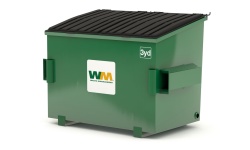When leasing a dumpster, numerous essential considerations can make all the difference in guaranteeing a smooth, efficient, and affordable waste disposal procedure. Establishing the right dumpster size is vital, as it straight affects expenses and efficiency. Rental period options, varying from a few days to numerous weeks or months, should be meticulously weighed to suit task requirements. In addition, recognizing debris type and weight limits, as well as placement and accessibility problems, can stop unforeseen expenses and safety and security problems. By taking into consideration these factors and budgeting as necessary, renters can assure an easy experience; discover the information of each factor to consider to optimize your dumpster rental.
Determining the Right Dumpster Size
When carrying out a task that calls for waste disposal, picking the suitable dumpster size is important to confirm efficient and cost-effective elimination of particles. Improperly sizing a dumpster can bring about additional costs, hold-ups, and also safety hazards
To identify the best dumpster dimension, consider the kind and volume of waste you anticipate to generate. Action the area where the dumpster will be placed to confirm it fits easily. Normal dumpster dimensions range from 10 to 40 cubic yards, with 20 and 30 cubic backyards being the most popular.
When approximating the quantity of waste, take into consideration the weight and density of materials. For example, heavy materials like concrete or asphalt call for larger dumpsters, while lighter materials like drywall or roof shingles can suit smaller ones.
Additionally, take into consideration http://piedmonttriaddumpsters.timeforchangecounselling.com/enhance-your-clean-up-with-dumpster-rentals any type of special requirements, such as cooling agent disposal or large appliance elimination. By accurately assessing your demands, you can select the ideal dumpster dimension, confirming a smooth and effective project.
Understanding Rental Period Options
A construction timeline is just as solid as its waste monitoring plan, and a crucial element of that plan is understanding rental period options for dumpsters.
Rental periods can vary relying on the job's scope and timeline, and it's essential to pick the right option to stay clear of unneeded extensions or fines. Commonly, rental periods range from a couple of days to numerous weeks or perhaps months.
Short-term rentals are ideal for little projects or occasions, while long-term rentals are better fit for large-scale construction or demolition projects. Some dumpster rental firms provide adaptable leasing durations, allowing you to change the period as needed.
It's important to discuss your task's details needs with the rental firm to identify the most cost-effective and convenient rental period. Be sure to inquire about any kind of additional charges connected with extensions or early discontinuation to ensure you're obtaining the best value for your money.
Debris Kind and Weight Limits
Here are some crucial factors to consider:
Heavy materials: Hefty materials like concrete, asphalt, and dirt have greater weight limitations than lighter products like paper and cardboard.
Hazardous materials: Unsafe materials like batteries, electronics, and chemicals need special disposal procedures and may not be allowed in regular dumpsters.
Organic materials: Organic materials like food waste and yard trimmings may go through particular regulations and weight limits.
Construction materials: Construction materials like roofing tiles, drywall, and lumber have details weight limits and disposal requirements.
Understanding the particles kind and weight limits of your dumpster rental is vital to ensure a smooth and cost-effective disposal process.
Placement and Ease of access Concerns
Proper dumpster positioning is just as important as recognizing debris type and weight limitations, as it straight impacts the efficiency and safety of the disposal procedure. A well-placed dumpster guarantees simple gain access to for packing and discharging, reducing the risk of mishaps and injuries.
It is important to identify a flat, steady surface that can support the weight of the dumpster and its components. Furthermore, the positioning needs to allow for sufficient space to navigate around the dumpster, enabling simple access for disposal trucks.
Accessibility is another vital factor to think about. Confirm that the dumpster is located in a location that is easily accessible for your team or family participants. This will certainly assist in reliable filling and lessen the threat of accidents.
Moreover, examine the proximity of the dumpster to the location where particles is being produced. Positioning the dumpster in close proximity can reduce labor costs and raise productivity.
Budgeting for Rental and Disposal
Establish a thorough allocate dumpster leasing and disposal by taking into consideration a number of vital aspects to avoid unforeseen expenses.

A tactical spending plan assurances you're planned for the expenses related to renting a dumpster and dealing with waste.
Rental Period: Compute the duration you'll need the dumpster, as this directly impacts the general cost.
Be sure to factor in any kind of prospective expansions or changes to your job timeline.
Dumpster Size: Pick a dumpster size that matches your task's requirements, as larger dumpsters set you back more.Consider the kind and volume of waste you'll be disposing of to choose the right size.
Disposal Fees: Study regional disposal charges, which differ depending on the type and weight of waste.Make sure to consist of these costs in your spending plan to avoid surprises.
Delivery and Pickup: Factor in the costs of supplying and getting the dumpster, in addition to any kind of prospective additional costs for fuel surcharges or take a trip time.